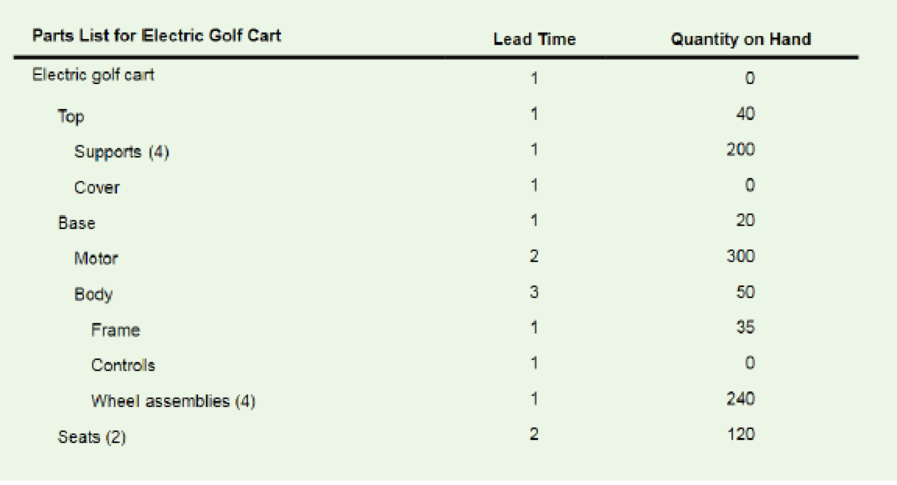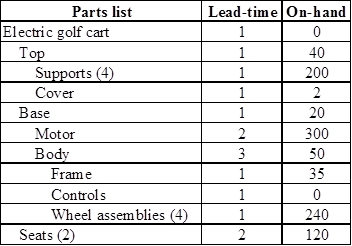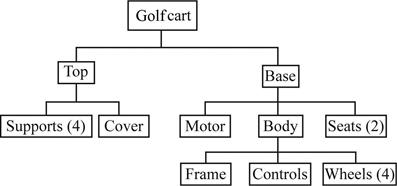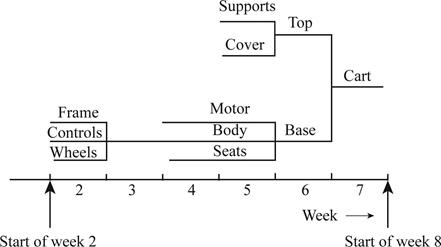
Concept explainers
A firm that produces electric golf carts has just received an order for 200 carts, which must be ready for delivery at the start of week 8. Information concerning the product structure, lead times, and quantities on hand is shown in the following table. Use this information to do each of the following:
a. Construct a product tree.
b. Construct an assembly time chart.
c. Develop a material requirements plan that will provide 200 golf carts by week 8 assuming lot-for-lot ordering.

a)
To construct: A product tree
Introduction: Materials Requirement Planning (MRP) is the planning or scheduling system, which can be used in the manufacturing process. It is used to plan the number of items required to produce one unit of finished goods (end item).
Explanation of Solution
Given information:

Construct a product tree:

b)
To construct: An assembly time chart
Introduction: Materials Requirement Planning (MRP) is the planning or scheduling system, which can be used in the manufacturing process. It is used to plan the number of items required to produce one unit of finished goods (end item).
Explanation of Solution
Given information:

Construct an assembly time chart:

c)
To prepare: Materials Requirement planning using the provided information.
Introduction: Materials Requirement Planning (MRP) is the planning or scheduling system, which can be used in the manufacturing process. It is used to plan the number of items required to produce one unit of finished goods (end item).
Explanation of Solution
Given information:
The company needs to provide 200 golf carts by week 8.

Develop a material requirement planning for golf cart:

- It is given that the company needs to provide 200 golf carts by week 8.
- Beginning inventory is 0 units.
- Net requirement can be calculated by subtracting the projected on-hand from the gross requirement. Hence, the net requirement is 200 units in week 8 (200-0).
- Planned order release is the order given by the company and planned order receipts is the order received by the firm.
- Lead-time is given as 1 week. Company requires 200 units in the beginning of Week 8. Hence, they need to order for 200 units (as the lot size is lot-for-lot) on previous week (as the lead-time is 1 week). Thus, company need to order the required units in week 7.
Develop a material requirement planning for top:

- Golf cart is the parent for top. Hence, the planned order release of the golf cart would be the gross requirement of the top. As number of units required is 1 for top, the planned order release row of golf cart should be multiplied with 1 to attain the gross requirement column of top.
- Beginning inventory is 40 units.
- Net requirement can be calculated by subtracting the projected on-hand from the gross requirement. Hence, the net requirement is 160 units in week 7 (200-40).
- Planned order release is the order given by the company and planned order receipts is the order received by the firm.
- Lead-time is given as 1 week. Company requires 160 units in the beginning of Week 7. Hence, they need to order for 160 units (as the lot size is lot-for-lot) on previous week (as the lead-time is 1 week). Thus, company need to order the required units in week 6.
- Projected on hand inventory for week 8 is 0 units. Calculation is as follows:
Develop a material requirement planning for supports (4):

- Top is the parent for supports. Hence, the planned order release of the top would be the gross requirement of the supports. As number of units required is 4 for supports, the planned order release row of top should be multiplied with 4 to attain the gross requirement column of support.
- Beginning inventory is 200 units.
- Net requirement can be calculated by subtracting the projected on-hand from the gross requirement. Hence, the net requirement is 440 units in week 6 (640-200).
- Planned order release is the order given by the company and planned order receipts is the order received by the firm.
- Lead-time is given as 1 week. Company requires 440 units in the beginning of Week 6. Hence, they need to order for 440 units (as the lot size is lot-for-lot) on previous week (as the lead-time is 1 week). Thus, company need to order the required units in week 5.
- Projected on hand inventory for week 7 is 0 units. Calculation is as follows:
Develop a material requirement planning for cover:

- Top is the parent for cover. Hence, the planned order release of the top would be the gross requirement of the cover. As number of units required is 1 for cover, the planned order release row of top should be multiplied with 1 to attain the gross requirement column of cover.
- Beginning inventory is 0 units.
- Net requirement can be calculated by subtracting the projected on-hand from the gross requirement. Hence, the net requirement is 160 units in week 6 (160-0).
- Planned order release is the order given by the company and planned order receipts is the order received by the firm.
- Lead-time is given as 1 week. Company requires 160 units in the beginning of Week 6. Hence, they need to order for 160 units (as the lot size is lot-for-lot) on previous week (as the lead-time is 1 week). Thus, company need to order the required units in week 5.
Develop a material requirement planning for base:

- Golf cart is the parent for base. Hence, the planned order release of the golf cart would be the gross requirement of the base. As number of units required is 1 for base, the planned order release row of golf cart should be multiplied with 1 to attain the gross requirement column of base.
- Beginning inventory is 20 units.
- Net requirement can be calculated by subtracting the projected on-hand from the gross requirement. Hence, the net requirement is 180 units in week 7 (200-20).
- Planned order release is the order given by the company and planned order receipts is the order received by the firm.
- Lead-time is given as 1 week. Company requires 180 units in the beginning of Week 7. Hence, they need to order for 180 units (as the lot size is lot-for-lot) on previous week (as the lead-time is 1 week). Thus, company need to order the required units in week 6.
- Projected on hand inventory for week 8 is 0 units. Calculation is as follows:
Develop a material requirement planning for motor:

- Base is the parent for motor. Hence, the planned order release of the base would be the gross requirement of the motor. As number of units required is 1 for motor, the planned order release row of base should be multiplied with 1 to attain the gross requirement column of motor.
- Beginning inventory is 300 units.
- Gross requirement for week 6 is 180 units. As the beginning inventory is sufficient to satisfy the demand, there is no necessary to place an order.
- Projected on hand inventory for week 7 is 120 units. Calculation is as follows:
Develop a material requirement planning for body:

- Base is the parent for body. Hence, the planned order release of the base would be the gross requirement of the body. As number of units required is 1 for body, the planned order release row of base should be multiplied with 1 to attain the gross requirement column of body.
- Beginning inventory is 50 units.
- Net requirement can be calculated by subtracting the projected on-hand from the gross requirement. Hence, the net requirement is 130 units in week 6 (180-50).
- Planned order release is the order given by the company and planned order receipts is the order received by the firm.
- Lead-time is given as 3 weeks. Company requires 130 units in the beginning of Week 6. Hence, they need to order for 130 units (as the lot size is lot-for-lot) before three weeks (as the lead-time is 3 weeks). Thus, company need to order the required units in week 3.
- Projected on hand inventory for week 7 is 0 units. Calculation is as follows:
Develop a material requirement planning for seats (2):

- Base is the parent for seats. Hence, the planned order release of the base would be the gross requirement of the seats. As number of units required is 1 for seats, the planned order release row of base should be multiplied with 1 to attain the gross requirement column of seats.
- Beginning inventory is 120 units.
- Net requirement can be calculated by subtracting the projected on-hand from the gross requirement. Hence, the net requirement is 240 units in week 6 (360-120).
- Planned order release is the order given by the company and planned order receipts is the order received by the firm.
- Lead-time is given as 2 weeks. Company requires 240 units in the beginning of Week 6. Hence, they need to order for 240 units (as the lot size is lot-for-lot) before two weeks (as the lead-time is 2 weeks). Thus, company need to order the required units in week 4.
- Projected on hand inventory for week 7 is 0 units. Calculation is as follows:
Develop a material requirement planning for frame:

- Body is the parent for frame. Hence, the planned order release of the body would be the gross requirement of the frame. As number of units required is 1 for frame, the planned order release row of body should be multiplied with 1 to attain the gross requirement column of frame.
- Beginning inventory is 35 units.
- Net requirement can be calculated by subtracting the projected on-hand from the gross requirement. Hence, the net requirement is 95 units in week 3 (130-35).
- Planned order release is the order given by the company and planned order receipts is the order received by the firm.
- Lead-time is given as 1 week. Company requires 95 units in the beginning of Week 3. Hence, they need to order for 95 units (as the lot size is lot-for-lot) on previous week (as the lead-time is 1 week). Thus, company need to order the required units in week 2.
- Projected on hand inventory for week 4 is 0 units. Calculation is as follows:
Develop a material requirement planning for controls:

- Body is the parent for controls. Hence, the planned order release of the body would be the gross requirement of the controls. As number of units required is 1 for controls, the planned order release row of body should be multiplied with 1 to attain the gross requirement column of controls.
- Beginning inventory is 0 units.
- Net requirement can be calculated by subtracting the projected on-hand from the gross requirement. Hence, the net requirement is 130 units in week 3 (130-0).
- Planned order release is the order given by the company and planned order receipts is the order received by the firm.
- Lead-time is given as 1 week. Company requires 130 units in the beginning of Week 3. Hence, they need to order for 130 units (as the lot size is lot-for-lot) on previous week (as the lead-time is 1 week). Thus, company need to order the required units in week 2.
Develop a material requirement planning for wheel assemblies (4):

- Body is the parent for wheel assemblies. Hence, the planned order release of the body would be the gross requirement of the wheel assemblies. As number of units required is 4 for wheel assemblies, the planned order release row of body should be multiplied with 4 to attain the gross requirement column of wheel assemblies.
- Beginning inventory is 240 units.
- Net requirement can be calculated by subtracting the projected on-hand from the gross requirement. Hence, the net requirement is 280 units in week 3 (520-240).
- Planned order release is the order given by the company and planned order receipts is the order received by the firm.
- Lead-time is given as 1 week. Company requires 280 units in the beginning of Week 3. Hence, they need to order for 280 units (as the lot size is lot-for-lot) on previous week (as the lead-time is 1 week). Thus, company need to order the required units in week 2.
- Projected on hand inventory for week 4 is 0 units. Calculation is as follows:
Want to see more full solutions like this?
Chapter 12 Solutions
EBK OPERATIONS MANAGEMENT
Additional Business Textbook Solutions
Financial Accounting: Tools for Business Decision Making, 8th Edition
Horngren's Accounting (12th Edition)
Principles of Microeconomics (MindTap Course List)
Essentials of MIS (13th Edition)
Horngren's Cost Accounting: A Managerial Emphasis (16th Edition)
Intermediate Accounting (2nd Edition)
- Do you feel there is anything positive about rework?arrow_forwardDo you think technology can achieve faster setup times? How would it be implemented in the hospital workforce?arrow_forwardIn your experience or opinion, do you think process changes like organizing workspaces make a bigger difference, or is investing in technology usually the better solution for faster setups?arrow_forward
- Have you seen rework done in your business, and what was done to prevent that from occurring again?arrow_forwardResearch a company different than case studies examined and search the internet and find an example of a business that had to rework a process. How was the organization affected to rework a process in order to restore a good flow unit? Did rework hurt a process or improve the organization's operational efficiency? • Note: Include a reference with supportive citations in the discussion reply in your post.arrow_forwardSetup time is very important in affecting a process and the capacity of a process. How do you reduce setup time? Give examples of reducing setup time. Please Provide a referenecearrow_forward
- Do you think TPS was successful? If so, how? Are there other companies that have used TPS? If so, give examples. Please provide a referencearrow_forwardGiven the significant impact on finances, production timelines, and even equipment functionality, as you pointed out, what do you believe is the most effective single strategy a company can implement to significantly reduce the occurrence of rework within their operations?arrow_forwardDurban woman, Nombulelo Mkumla, took to social media last week to share how she discovered the rodent.In a lengthy Facebook post, she said she purchased the loaf of bread from a local shop after work on August 27.For the next days, Mkumla proceeded to use slices of bread from the load to make toast."Then, on the morning of August 31, I took the bread out of the fridge to make toast and noticed something disgusting andscary. I took a picture and sent it to my friends, and one of them said, 'Yi mpuku leyo tshomi' [That's a rat friend]“."I was in denial and suggested it might be something else, but the rat scenario made sense - it's possible the rat got into thebread at the factory, and no one noticed," Mkumla said.She went back to the shop she'd bought the bread from and was told to lay a complaint directly with the supplier.She sent an email with a video and photographs of the bread.Mkumla said she was later contacted by a man from Sasko who apologised for the incident.According to…arrow_forward
- PepsiCo South Africa says the incident where a woman discovered part of a rodent in her loaf of bread, is anisolated occurrence.Durban woman, Nombulelo Mkumla, took to social media last week to share how she discovered the rodent.In a lengthy Facebook post, she said she purchased the loaf of bread from a local shop after work on August 27.For the next days, Mkumla proceeded to use slices of bread from the load to make toast."Then, on the morning of August 31, I took the bread out of the fridge to make toast and noticed something disgusting andscary. I took a picture and sent it to my friends, and one of them said, 'Yi mpuku leyo tshomi' [That's a rat friend]“."I was in denial and suggested it might be something else, but the rat scenario made sense - it's possible the rat got into thebread at the factory, and no one noticed," Mkumla said.She went back to the shop she'd bought the bread from and was told to lay a complaint directly with the supplier.She sent an email with a video and…arrow_forwardDurban woman, Nombulelo Mkumla, took to social media last week to share how she discovered the rodent.In a lengthy Facebook post, she said she purchased the loaf of bread from a local shop after work on August 27.For the next days, Mkumla proceeded to use slices of bread from the load to make toast."Then, on the morning of August 31, I took the bread out of the fridge to make toast and noticed something disgusting andscary. I took a picture and sent it to my friends, and one of them said, 'Yi mpuku leyo tshomi' [That's a rat friend]“."I was in denial and suggested it might be something else, but the rat scenario made sense - it's possible the rat got into thebread at the factory, and no one noticed," Mkumla said.She went back to the shop she'd bought the bread from and was told to lay a complaint directly with the supplier.She sent an email with a video and photographs of the bread.Mkumla said she was later contacted by a man from Sasko who apologised for the incident.According to…arrow_forwardRead the project statement and answer ALL of the questions that follow PROJECT STATEMENT The African Integrated High-Speed Railway Network (AIHSRN). African nations are preparing to invest billions in a significant overhaul of their rail infrastructure as part of an ambitious plan for the continent. One of the key projects underway is the African Integrated High-Speed Railway Network (AIHSRN), which aims to connect Africa's capital cities and major commercial centres with a high-speed railway network to enhance continental trade and competition. This network will span 2,000 km (1,243 miles) and connect 60 cities, including Nairobi, Lagos, Cairo, and Dakar. It will improve access to essential markets, enhance economic cooperation, and encourage regional collaboration. The plan is poised to revolutionise intra-African trade by reducing travel times and lowering transportation costs, making trade between African nations more competitive. The trains will be capable of reaching speeds of up…arrow_forward
 Practical Management ScienceOperations ManagementISBN:9781337406659Author:WINSTON, Wayne L.Publisher:Cengage,MarketingMarketingISBN:9780357033791Author:Pride, William MPublisher:South Western Educational Publishing
Practical Management ScienceOperations ManagementISBN:9781337406659Author:WINSTON, Wayne L.Publisher:Cengage,MarketingMarketingISBN:9780357033791Author:Pride, William MPublisher:South Western Educational Publishing Purchasing and Supply Chain ManagementOperations ManagementISBN:9781285869681Author:Robert M. Monczka, Robert B. Handfield, Larry C. Giunipero, James L. PattersonPublisher:Cengage Learning
Purchasing and Supply Chain ManagementOperations ManagementISBN:9781285869681Author:Robert M. Monczka, Robert B. Handfield, Larry C. Giunipero, James L. PattersonPublisher:Cengage Learning Contemporary MarketingMarketingISBN:9780357033777Author:Louis E. Boone, David L. KurtzPublisher:Cengage Learning
Contemporary MarketingMarketingISBN:9780357033777Author:Louis E. Boone, David L. KurtzPublisher:Cengage Learning





